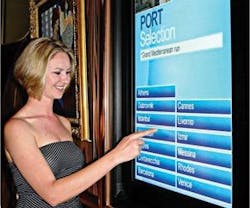Digital Signage Replaces Traditional Signage
Imagine walking into a building to find out where a particular law firm’s office is located – instead of a traditional sign, you’re greeted with a 42-inch touchscreen. Not only does it provide the firm’s suite number, but it also offers hours of operation, the services offered, building info, and animated directions to the suite.
Digital signage has been steadily cropping up in many markets over the last several years and is revolutionizing the way organizations communicate with customers and employees. Look around and you’ll realize how many printed signs have been replaced by digital ones. Even huge billboards along highways are being converted to digital. Flat screens have replaced posters in retail stores, medical offices, restaurants, schools, and universities – and they’ve even been integrated into elevators and taxis.
So, how’s digital signage different from other forms of communication? First, it has the ability to reach people with a message relevant to their location – the office, on campus, or the airport.
Second, it’s dynamic. When networked together through the Internet, screens can be updated from a remote location. Screens can also include live news or weather feeds, provide interaction with touchscreens or mobile phones, and be scheduled to deliver specific messages based on time of day, event, or audience.
Digital signage can fulfill a variety of communications objectives: branding, merchandising, promotion, education, information, wayfinding, and entertainment, as well as employee and customer communication. It can add vitality and energy to an environment, and reduce perceived waiting times where lines are present.
After determining what you want the signage to achieve, a content plan needs to be developed. Determine the source of the content (such as an RSS feed) and who will be responsible for monitoring and maintaining the content. Content-management software designed for digital signage makes this easier and offers templates you can use if you don’t want to create your own. The most important thing is that the content looks professional.
As far as the technology, there are four types of screens: LCD, plasma, projection, and LED. In addition to cost, you’ll want to consider appropriate size, impact of ambient lighting, integration into the facility, and product life-cycle.
Signage networks are powered by one or more media players, which are pieces of hardware much like a computer, but designed to play various forms of digital media on the screen. If the content doesn’t change very often, it can be updated using flash drives or memory cards. If you plan to have an RSS feed, or want the ability to update the content remotely, you’ll need an Internet connection. If you’re managing several screens across many locations, networking the screens makes sense.
With digital signage, you can add sophistication and smart technology to your facility. Based on your objectives and your budget, the outcome could be a single screen in one location or multiple screens in multiple locations. Regardless of what you choose, you’re providing the facility with a way to greatly enhance communications, improve aesthetics, and save money.
David Drain is executive director at the Louisville, KY-based Digital Signage Association.
